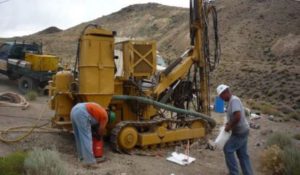Newrange puts focus on high-grade gold exploration at historic Pamlico property

Drilling operations at Newrange Gold's Pamlico Project in western Nevada. Source: Newrange Gold Corp.
By Peter Kennedy
If anyone thought that all the gold in Nevada has already been found, they haven’t spoken to Bob Carrington lately. Carrington is President and CEO of Newrange Gold Corp. [NRG-TSXV], a company that was focused on exploration in Colombia until the opportunity came up last year to acquire a property in one of Nevada’s historic gold districts, not far from the famous Comstock District.

It was through a friend of Carrington’s father that Newrange was able to acquire an option on the high-grade Pamlico gold project, a move the prompted the company to change its name to Newrange from Colombian Mines Corp. Carrington seized on the opportunity because he believed Pamlico offered his company the chance to explore and develop a district scale, near surface, potentially high-grade gold deposit.
It should be noted that exploration to date has been insufficient to define a mineral resource that would meet NI 43-101 standards of disclosure. However, Carrington’s optimism is based on Pamlico’s location and previous history.
Situated along the Walker Lane Trend in Mineral County in western Nevada, one of the state’s largest and most productive gold trends, it is comprised of 116 unpatented mining lodge claims, covering the historic Pamlico Group of underground mines, as well as the surrounding Good Hope, Central, Gold Bar and Sunset Mines.
After the initial discoveries were made around 1884, reports say ore was soon being shipped from the site to custom mills in the Aurora and Comstock (Virginia) Districts. Drilling by previous operators and owners intersected very high-grade mineralization. Records show that one historic drill hole intersected 4.6 metres grading 239.7 g/t gold, and included 0.8 metres assaying 702.5 g/t gold in an area called the Merritt Zone.
But due to the fact that the property been in private hands since 1898, it remained underexplored and relatively untested by modern exploration techniques. Only 103 shallow holes had been drilled in the entire property when it was acquired by Newrange in July 2016.
Still, hopes that Newrange will outline an economic resource are based on the extent and grade of the gold mineralization in historic surface and underground samples, the high-grade nature of historic gold production, and available drill results.
Under the July 2016 agreement, Newrange obtained the option to purchase a 100% interest in the Pamlico property, either by (1) paying the owner $4 million in cash, including advance minimum royalties and production royalties (4% NSR) within four years; or (2) pay $7.5 million in cash, including advance minimum royalties and production royalties so long as annual payments are equal to or exceed $250,000.
Upon signing, the company committed to pay $50,000 with a second payment of $150,000 due within six months. Payments of $250,000 are due on each anniversary of the signing date thereafter until the total purchase price, as per option (1) or (2), has been paid. The 4% NSR can be bought down to 1% by paying the owner $1 million per percentage point.
The payment schedule was altered slightly in December 2016 to reflect prevailing market conditions. Under the amended agreement, Newrange consented to pay the owners US $25,000 on December 15, 2016, and another US $125,000 by March 1, 2017.
Since the option agreement was signed, the company has completed some channel sampling in a large decline that the family had developed at a cost of about $3 million. It has also drilled about 40 holes, of which 32 have been announced, and flown geophysical surveys over the entire property.
The 188-metre long decline was developed to permit test mining of high-grade mineralization that had previously been identified by drilling just beyond the face of the decline. In May, 2017, the company said sampling in the decline had identified multiple high-grade structures assaying from 28.90 g/t gold over 1.5 metres to 104.75 g/t over 1.5 metres within an extensive zone of disseminated mineralization averaging 2.92 g/t gold over 75.5 metres in the decline.
In early November 2017, the company said drilling had encountered two new high-grade gold zones, known as the K-Zone and N-Zone. Drilling in the K-Zone returned an intersection of 16.87 g/t gold over 4.6 metres, the company said.
Over the course of the next year, the company will be gathering permits to advance the decline in a bid to get a hands on look at the geometry and the details of the high-grade zones.
Newrange is also planning to do 100,000 metres of additional drilling.
The company hopes to take a bulk sample out of the decline and conduct metallurgical studies on that [material] to confirm the metallurgical characteristics of the deposit. Exploration crews will step out onto other target zones and do initial drilling on those zones.
“One of the keys to success in this whole industry is having enough grade to so that when gold prices start declining, you can be the last man standing,” Carrington said during an interview with Sean Brodrick, a Florida-based investment writer and analyst.
“I think with a project like Pamlico, we will be.”
